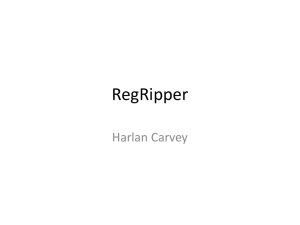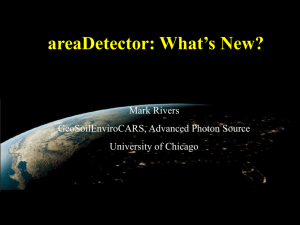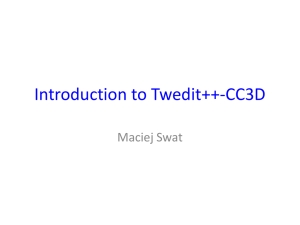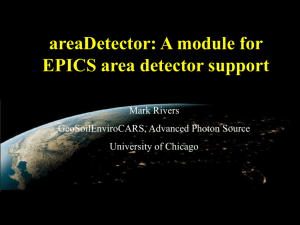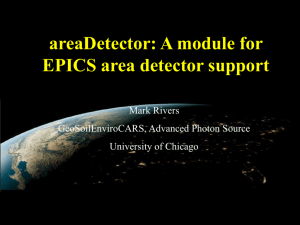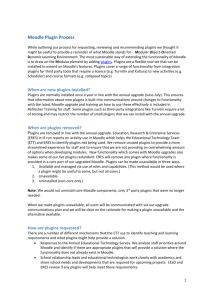EPICS V4 areaDetector integration
advertisement
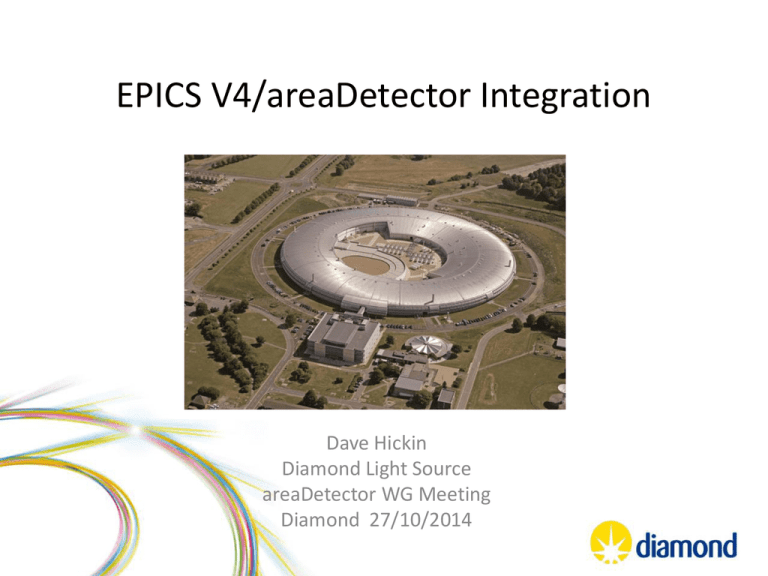
EPICS V4/areaDetector Integration Dave Hickin Diamond Light Source areaDetector WG Meeting Diamond 27/10/2014 Overview • • • • EPICS V4 basics ADPvAccess plugin and driver Embed ADPvAccess driver V4 areaDetector EPICS V4 Basics • V4 adds structured data to EPICS • V4 modules • • • • pvData – structured data pvAccess – network protocol pvaSrv – pvAccess server on V3 IOC pvDatabase – V4 records/database and pvAccess • pvaSrv and pvDatabase are C++-only pvData basics • Basic types • scalar, structure, tagged union, variant union • arrays of these • Scalar types • • • • Booleans Signed and unsigned integers (8-, 16-, 32-, 64-bit) Floats and doubles Strings pvDataCPP basics • Extensive use of boost shared pointers • Array types use reference counted shared vector • Copy-on-write semantics • Arrays of complex types use shared vectors of shared pointers • Unions have shared pointer to top-level field pvDataCPP basics • Data can be shared or shallow or deep-copied • Shallow-copy easy and avoids copying large arrays • Care needs to be taken with unions and arrays of complex data types • Const is not implemented – but could be added • Sharing currently problematic • References can be hung onto pvAccess basics • Create/destroy pvAccess channel • Channel services • • • • • • Introspection Get, Put, PutGet Monitor Process RPC Channel array NTNDArray • V4 Structure encoding NDArray • • • • • • • Array data uses unions of scalar arrays Attributes use variant unions (anys) Dimension and attribute use structure arrays Timestamps UniqueId Data sizes Codec for compression encoding • Normative type (replaces NTImage) Issues to think about • Monitors do shallow copy • Structures could be shared (const would help) or shallow-copied • References can be held onto • How to do free-lists • Monitors have overflow bit but no dropped frame count ADPvAccess Plugin/Driver • V4 sever-side plugin and client-side driver • Plugin puts NDArray data in V4 structure and publishes it via pvAccess • Client monitors and converts V4 structures to NDArrays • Allows local and remote transfer of NDArrays • Compression (through Blosc/LZ4) Performance on 10 Gig Ethernet • Uncompressed • 120-122 frames per second (97-99+% bandwidth) • Compressed • With compression image reduced to 36% of original size using lz4 and 38% by Blosc • Single threaded compression reduces performance • Blosc-based compression (multithreaded) increases rate • Blosc + lz4 best. Up to ~230 frames per second (190% of bandwidth) Current and near future work • Complete move to NTNDArray from NTImage • Move to GitHub Module - ADPvAccess • Package and release • Integration with other EPICS developments especially CS-Studio • Windows build • Deploy on beamline (I12 is candidate) Embed ADPvAccess driver • Local plugins (in same process) connect to NDArray driver as usual • If NDArray driver not present, first plugin creates V4 monitor client driver monitors “PV” and plugin connects to this • Subsequent plugins connect to this local driver • Avoids having to explicitly create client driver • Monitor stops when all plugins disabled V4 areaDetector drivers • • • • Put frame data direct into NTNDArray V4 client plugins consume NTNDArrays Can publish frame easily as “PV” Avoids conversion from NDArray and V4 server plugin • Straight-forward to re-write drivers • V4 SimDetector prototyped • Existing NDArray-plugins can be run though ADPvAccess client V4 client plugins • areaDetector plugins can be rewritten to process NTNDArrays – straight-forward • New V4 plugins can consume NTNDArray • V4 client plugins can work with old drivers through ADPvAccess server plugin • Various options for passing frames to plugins Option 1 - Clients use pva monitors • • • • Clients create monitor to NTNDArray Monitor queues can be used to queue frames Only required fields need be monitored Local (same process) monitors perform shallow copy • Multiple remote monitors transfer data multiple times Option 2 - Plugins use single monitor • First plugin registers with “PV”. Creates monitor. S/W layer/object to manage this. Plugin registers with monitor • Plugin gets a call-back. Passed an NTNDArray (const) shared or shallow copy • Subsequent plugins register, but no new monitor created • Each plugin can have own queue and processing thread Option 3 - Plugins use single monitor remotely, multiple locally • For first plugin creates monitor. S/W layer/object to manage this. Republishes local-only PV. Client monitors this • Additional plugins monitor local PV • Plugins can use monitor queues Option 4 - PVManager • Handles queue/buffering/aggregation and background data processing • Java only. No C++ implementation yet • Abstract types (Vtypes). One for NTNDArray • Used in CSS • Single channel/monitor to “PV” • Could it be used for plugins? • Limited vtypes
